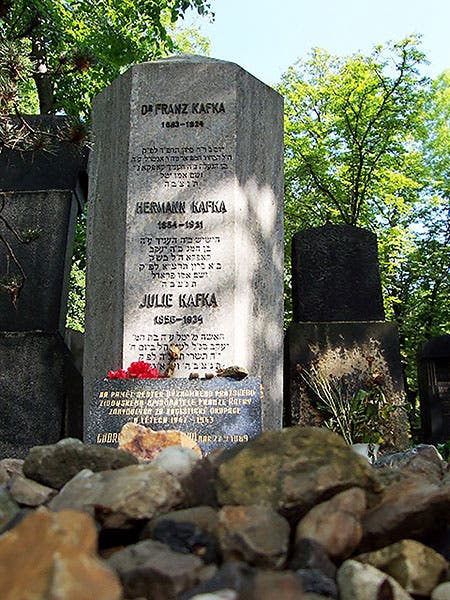Scientist of the Day - Franz Kafka
Franz Kafka, a Jewish Bohemian writer, was born July 3, 1883. Kafka doesn’t make it into most history of science surveys, which is too bad, because he wrote one of the great entomological short stories of all time, Die Verwandlung (The Metamorphosis, published in 1915). As I am sure everyone knows, even those who have never read the story, Gregor Samsa awakens in the first sentence to find that he has been transformed into a gigantic insect. Actually, the term that Kafka used for the end product of Gregor’s metamorphosis was Ungeziefer, which means “an unclean animal unsuitable for sacrifice,” or, colloquially, a “bug.” Critics have had a field day adjudicating exactly what kind of bug awoke in Samsa’s bed; they have pretty well rejected “cockroach”, and “dung beetle,” but since Kafka was deliberately obscure on the matter, it is hard to say. All we know for sure is that Gregor was roundish, with tiny legs, and mandibles strong enough to open a door.
So on this vital question, we will side with Vladimir Nabokov, not only a great writer himself, but an avid bug collector as well. In a lecture that he regularly gave at Cornell (he was on the faculty there from 1948-58), Nabokov argued for Gregor’s having been transformed into a beetle. You can read Nabokov’s lecture here (you may skip over the first part, on Dr. Jekyll and Mr. Hyde), but it is much more fun, if you have 30 minutes to spare, to watch Christopher Plummer’s re-enactment of Nabokov’s lecture, a performance that was recorded in 1989 before a willing student retro-audience at Cornell. It is quite a riveting performance. Sometimes I think we teachers should just retire and turn the classroom over to stage actors – they really do a much better job. We may think we know more than they do, but who can tell, when they have a great script, and possess stage skills that push us back deep into the wings.
Another Kafka story with a scientific theme (of sorts) is "Die Sorge des Hausvaters" (“The Cares of a Family Man”), written before 1917 and published in 1919. This is a very short story – I could reprint the entire piece in this post without taking up much more space – but it is one of the most discussed of all his works. The story centers around Odradek, an object somewhere between the living and the mechanical. It is described as looking like a spool with star-shaped ends, wrapped with odds and ends of threads, and with several rods that stick out and allow it to move. It looks unfinished, but it doesn't appear to be missing anything. It dwells in the family man's house, in closets and under stairwells, and it occasionally speaks, but it is too elusive to be caught. And it seems to have no purpose. “Anything that dies has had some kind of aim in life, some kind of activity, which has worn out; but that does not apply to Odradek”. Thus the family man has to deal with the grim prospect that he, with all his cares and hopes, will die, while Odradek will linger on to lurk under the stairs of his children.
It is hard to say what the story is about – it is almost too short to be about anything – but it arouses uneasy feelings in most readers – certainly it did in me. It seems to say that our human strivings and our mortality are opposite sides of the same coin. Odradek, with no reason to live, has no reason to die. The family man has every reason to live, and is consequently doomed.
You can read the entire story here – you see, it really is very short. Or you can view a light box by Jeff Wall, with Odradek in the title, which shows our paradoxical entity, if you can find him (fourth image). We will help you with a detail; perhaps you can make out the thread-wound spool with sticks for appendages, under the stairs, and unseen (of course) by the woman descending (fifth image).
Jorge Luis Borges wrote a wonderful short essay called "Kafka and his Precursors" (Other Inquisitions, Engl. tr., 1964) ), in which he found precedence for Kafka in texts by Zeno, Han Yu, Kierkegard, Robert Browning and Leon Bloy. Borges noted that if Kafka had never existed, these precursors would have nothing in common. They were not responsible for giving us Kafka; rather, Kafka was responsible for bringing them together and requiring us to read them in a new way. Karka created his own precursors, suggested Borges, a thoughtful sentiment indeed.
The beetle image above (first image), one of the loveliest renditions of a beetle ever made, is from Edward Donovan’s Natural History of the Insects of India (1800); we included it for its beauty and semi-relevance, although there is no mention that Gregor Samsa had stag-horns. We see also the title page to the first printing of The Metamorphosis (third image). Kafka died of tuberculosis in Vienna in 1924 and was returned to Prague for burial, where he shares a stone with his parents, both of whom outlived him (sixth image).
Many thanks to Erika Honisch for introducing me to Odradek and Jeff Wall’s lightbox. Professor Honisch has a dog Coco, who has been called, on occasion, Cocodradek.
Dr. William B. Ashworth, Jr., Consultant for the History of Science, Linda Hall Library and Associate Professor, Department of History, University of Missouri-Kansas City. Comments or corrections are welcome; please direct to ashworthw@umkc.edu.









![“Aurora Borealis,” hand-colored wood engraving by Josiah Wood Whymper, [Natural Phenomena], plate 2, 1846 (Linda Hall Library)](https://assets-us-01.kc-usercontent.com:443/9dd25524-761a-000d-d79f-86a5086d4774/0245ffcb-b70c-477c-8792-0a73ebd54eb2/Whymper%2011.jpg?w=210&h=210&auto=format&fit=crop)

